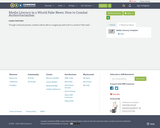
Through continued practice, students will be able to corageously seek truth in a world of 'fake news'
- Subject:
- Composition and Rhetoric
- English Language Arts
- History
- Material Type:
- Lesson Plan
- Author:
- Josef Schneider
- Date Added:
- 05/18/2018

Through continued practice, students will be able to corageously seek truth in a world of 'fake news'

Media, Society, Culture, and You is an approachable introductory Mass Communication text that covers major mass communication terms and concepts including "digital culture." It discusses various media platforms and how they are evolving as Information and Communication Technologies change.
This book has been peer-reviewed by 6 subject experts and is now available for adoption or adaptation. If you plan to adopt or adapt this open textbook, please let us know by filling out our adoption form (https://docs.google.com/forms/d/e/1FAIpQLSdIj_Te3hiuJL7cKaofhhUHuDz3_hlVXg6Wg1IPcDZoH2pRrg/viewform?usp=sf_link).
You can view the book's Review Statement (https://press.rebus.community/mscy/back-matter/review-statement/) for more information about reviewers and the review process. An Accessibility Assessment (https://press.rebus.community/mscy/back-matter/accessibility-assessment/) for this is book has also been prepared to see how this book meets accessibility standards.

This workshop explores the potential of media technology and the Internet to enhance communication and transform city design and community development in inner-city neighborhoods. The class introduces a variety of methods for describing or representing a place and its residents, for simulating actions and changes, for presenting visions of the future, and for engaging multiple actors in the process of envisioning change and guiding action. Students will engage one neighborhood, meet real people working on real projects, put theory into practice, and reflect on insights gained in the process.
This year the course will examine what it means to be an urban designer/planner and how to create a digital teaching tool (using digital storytelling) that supports others in learning about the relationship between design and planning professionals, on the one hand, and members of the communities they serve, on the other. What is the nature of the knowledge that resides in a community and how can designers and planners learn about, tap, and use that knowledge? What is the relationship between community organizing and urban design and planning? What are the relationships between you as a professional, the place(s) in which you work, and the values and care you bring to that work?
We will explore these themes in the context of Camfield Estates in Lower Roxbury, MA and its participation in the US Department of Housing and Urban Development's (HUD) Demonstration Disposition Project. There have been many stories written about Camfield Estates' participation in the Demonstration Disposition project, for it has been widely regarded as a model of success. There are two stories that have not yet been told, however: the story of the residents who organized the community and the story of the architects and planners who participated in the project. This course will use digital storytelling to reconstruct and connect these two stories.

In this course students create digital visual images and analyze designs from historical and theoretical perspectives with an emphasis on art and design, examining visual experience in broad terms, and from the perspectives of both creators and viewers. The course addresses key topics such as: image making as a cognitive and perceptual practice, the production of visual significance and meaning, and the role of technology in creating and understanding digitally produced images. Students will be given design problems growing out of their reading and present solutions using technologies such as the Adobe Creative Suite and/or similar applications.
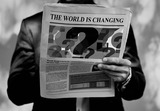
Students will look at an overview of the rise of mass news media in the U.S.. They will then study the Civil Rights movement through the lens of media coverage to determine the impact news coverage of violence against peaceful protestors helped lead to social change.

This seminar is about the pleasures and power of reading. From the Sumerian clay tablets of more than four millenia ago through the spectacular emergence of the electronic text, the written word—in all its forms—has captivated the human mind, embodied our insights into the world around us, and made enduring our most profound artistic creations and scientific discoveries.

This course centers on historical eras in which the form and function of media technologies were radically transformed. It includes consideration of the "Gutenberg Revolution," the rise of modern mass media, and the "digital revolution," among other case studies of media transformation and cultural change. Readings are in cultural and social history and historiographic method.

This lesson will explore the model minority myth, introduced in the 1960s by publications such as The New York Times Magazine and U.S. News & World Report, applied on Asian American, Native Hawaiian, and Pacific Islander (AANHPI) and examine the realities and experiences of this non-monolithic community. Students will use data from the U.S. Census to compare and contrast AANHPI communities. Students will then look at the 2018 lawsuit against Harvard University’s admission policies as a case study to investigate the ways the model minority myth can be used as a wedge between different communities of color.
2021 Social Science Standards Integrated with Ethnic Studies:
Geography: 5.13
Historical Knowledge: 5.22, 6.20, 6.21, 8.22, 8.25, HS.52, HS.57, HS.60, HS.61, HS.63, HS.64, HS.65
Historical Thinking: 5.24, 7.25, 8.31, 8.32, HS.68
Social Science Analysis: 5.26, 5.27, 6.24, 6.27, 8.33, 8.36, HS.72, HS.73, HS.74
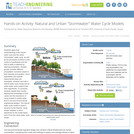
Students apply their understanding of the natural water cycle and the urban "stormwater" water cycle, as well as the processes involved in both cycles to hypothesize how the flow of water is affected by altering precipitation. Student groups consider different precipitation scenarios based on both intensity and duration. Once hypotheses and specific experimental steps are developed, students use both a natural water cycle model and an urban water cycle model to test their hypotheses. To conclude, students explain their results, tapping their knowledge of both cycles and the importance of using models to predict water flow in civil and environmental engineering designs. The natural water cycle model is made in advance by the teacher, using simple supplies; a minor adjustment to the model easily turns it into the urban water cycle model.

Through an overview of the components of the hydrologic cycle and the important roles they play in the design of engineered systems, students' awareness of the world's limited fresh water resources is heightened. The hydrologic cycle affects everyone and is the single most critical component to life on Earth. Students examine in detail the water cycle components and phase transitions, and then learn how water moves through the human-made urban environment. This urban "stormwater" water cycle is influenced by the pervasive existence of impervious surfaces that limit the amount of infiltration, resulting in high levels of stormwater runoff, limited groundwater replenishment and reduced groundwater flow. Students show their understanding of the process by writing a description of the path of a water droplet through the urban water cycle, from the droplet's point of view. The lesson lays the groundwork for rest of the unit, so students can begin to think about what they might do to modify the urban "stormwater" water cycle so that it functions more like the natural water cycle. A PowerPoint® presentation and handout are provided.
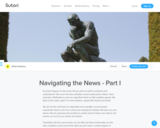
An event happens in the world. We go online to inform ourselves and understand it. We scour the web, websites, social media posts, videos, reels, podcasts. Notifications come up, algorithms feed us, filter bubbles appear. We listen to the radio, watch TV news bulletins, speak with friends and family.
We aim for the cold facts, for objectivity and neutrality. Unconsciously meanwhile, factors out of our control are shaping the debate. We have our own biases. We are exposed and sensitive to certain point of views over others. Our senses, as much as our minds, are tricked.
Thankfully, with the correct tools, we can filter the flow of information on the web, navigate current events the right way and reach a certain degree of objectivity. This resource aims to help do just that.
This first part is about grasping the unconscious factors at play. Being aware of our limitations is the beginning to understanding news and the world we live in. It is also a means to open up to different point of views, as well as the colourful complexity of knowledge.
In the second part, we'll look at a concrete use case and how we can use critical thinking to filter information online.
--
This resource is part of the information science collection.
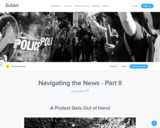
This second part of the "Navigating the news" resource begins with the news of a fictional protest in a city. We live this event as if it were breaking, as we gradually pick up pieces of information (from speculative tweets to memes, opinions to out of context media) react and share.
The aim is to show how typical this is of how we consume news online, whether breaking or not. We are fed superficial, incomplete, sometimes fake, often biased information on a regular basis.
But not all is lost! This resource shows students that good habits can make an impact and help us navigate the news in a healthy way. The good habits are:
Pausing & taking a step back
Embracing the nuance
Keeping an eye on the bigger picture
Developing critical thinking
This last one, critical thinking, is divided into the following sections:
News articles
Media neutrality & the left-right divide
Experts & authorities
Opinion pieces & commentators
Algorithm
Stats
Studies
Social media
It finishes off with the Bullshit-o-meter, a framework to quantify the quality of a source. Concretely you add or reduce credit depending on how valid the information contained within a source is.
--
This resource is part of the information science collection.

Visual Arts Content and Achievement Standards for the state of North Dakota. Updated 2000.

This is a training project for course Media Production and the Internet. Це тренувальний пілотний проект про медіавиробництво та Інтернет

Within twenty-four hours of the attack on the World Trade Center on September 11, 2001 politicians, artists, and cultural critics had begun to ask how to memorialize the deaths of thousands of people. This question persists today, but it can also be countered with another: is building a monument the best way to commemorate that moment in history? What might other discourses, media, and art forms offer in such a project of collective memory? How can these cultural formations help us to assess the immediate reaction to the attack? To approach these issues, "Out of Ground Zero" looks back to earlier sites of catastrophe in Germany and Japan.

According to a 2012 study, 81% of U.S. teenagers reported looking at online health information for their needs (Park & Kwon, 2018). For this reason, it is increasingly important to consider ways to promote and model effective digital health literacy. This module is designed not to dissuade adolescents from using digital resources to find health information, but rather equipping them with the tools to find reputable resources and responsibly use them to inform conversations with their health providers. This learning module is divided into three sub-modules (each 20-30 min in length) that are designed to be taught in separate sessions, or as part of a singular digital health literacy workshop/bootcamp. Please feel free to use any parts of this module that you feel could best empower your students to actively engage in their health and wellness.
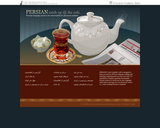
PERSIAN Catch Up@the Café is designed to help you practice Persian language reading and listening comprehension on your own time. It’s intended for English speaking intermediate Persian learners to brush up on your language skills before moving on to an advanced course: i.e., some existing Persian is required.
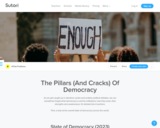
As we get caught up in elections cycles and endless political debates, we can sometimes forget what democracy is and its institutions; how they work, their strengths and weaknesses. It's divided into 5 sections.
The state of democracy
The first part looks at the overall state of democracy across the world. After definining what a democracy is, we're look at how not all democracies are equal in measure, with some having more functioning democratic institutions than others. A useful recap of the other major types of government will feature.
Checks and balances
The separation of powers (legislative, executive and judicial) come from the premise that concentrating power in the hands of one person, party or government can have a detrimental effect on society. Hence why power and functions are distributed across separate and independent entities.
Thriving political culture
A democracy is more than voting once every x number of years. It's first of all making sure everyone who is elligible to vote can easily do so (obstacles are common). Political culture is also determined through the freedom to contest and protest.
Transparency, accountability & corruption
It is a given that a functioning democracy, with politicians elected by the people who get to decide how tax-payer money is spent, decision-making processes and accounting should be as transparant and corruption-free as possible. Unfortunately, lobbying and other forms of corruption are proven to be a hindrance on democracy as a whole.
Media: the fourth power
What is discussed in media outlets - from podcasts to TikTok videos, news articles to TV news bulletins - can have a significant impact on society, raising matters of public interest, forcing politicians to take position, debate and take action.
Hence the importance of a free press. One that is independent, can speak openly about any issue, criticise the government if need be, without fear of reprisal. It is also crucial that information is transparent, that journalists can access information on what governments are doing without hindrance.
--
Part of the political science collection.
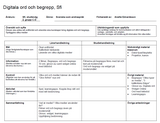
Lektionsplaneringen är tänkt att fungera som inspiration för att använda digitala lärresurser i undervisningen. Planeringen innehåller bland annat länkar till Glosor.eu och learningapps där eleven kan öva på ord och begrepp. (Vid vissa delar av planeringen används betaltjänster)

This course focuses on methods of digital visualization and communication and their application to planning issues. Lectures will introduce a variety of methods for describing or representing a place and its residents, for simulating changes, for presenting visions of the future, and for engaging multiple actors in the process of guiding action. Through a series of laboratory exercises, students will apply these methods in the construction of a web-based portfolio. The portfolio is not only the final project for the course, but will serve as a container for other course work throughout the MCP program.
This course aims to introduce students to (1) such persistent and recurring themes as place, race, power and the environment that face planners, (2) the role of digital technologies in representing, analyzing, and mobilizing communities, (3) MIT faculty and their work, (4) MIT's computing environment and resources including Athena, Element K, the ESRI virtual campus, Computer Resources Laboratory (CRL), Campus Wide Information Systems Support (CWIS), the GIS Laboratory at Rotch Library and (5) software tools like Adobe® Photoshop® and Illustrator®, ESRI ArcView, Microsoft® Access, and Macromedia® Dreamweaver® that will assist them in creating digital images, working with relational databases, and launching a web-based portfolio.